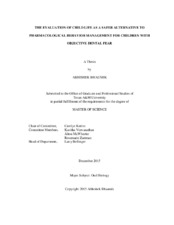| dc.description.abstract | The purpose of this pilot study was to evaluate dental child-life therapy as a safe alternative to pharmacological behavior management techniques in school-age dental patients with past negative dental experiences. Seventeen fearful, uncooperative children (ages 5-11 years) with prior negative dental experiences were randomly assigned to experimental (Child Life) or control (sedation) groups. Children in both groups underwent two consecutive invasive dental restorative appointments provided by the same blinded dentist. The experimental group received three sessions of child-life therapy prior to receiving dental restorative treatment. The control group did not receive child-life interventions but were treated using meperidine and promethazine oral conscious sedation. The appointments were videotaped, and then analyzed by three calibrated, blinded examiners. Behavior was rated at specific standardized segments of treatment including seating in the chair, local anesthetic administration, rubber dam placement, and timed components of restorative care using the Modified Houpt Scale and the Frankl Score. Ratings were compared between control and experimental groups after each procedure and between first and second appointments. There was no significant difference between behaviors at all time points between visit one and visit two for the control group (p >0.317). Similarly, there was no significant difference between behaviors at all time points between visit one and visit two for the experimental group (p >0.102). Additionally, there was no significant difference between the consensus Frankl score by the video reviewers and the operator. (p=0.24 control group; p=0.137 experimental group). There was no significant difference in behavior between control visit one and experimental visit one (p >0.328). The results suggest that oral conscious sedation remains an effective choice for patients with objective dental fear. Child life therapy is also an effective choice for patients with objective fear given the lack of difference in behaviors between treatment groups for the first visit. Child life therapy has substantivity as demonstrated by similar behavior scores between the first and second visit. | en |


